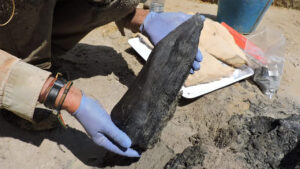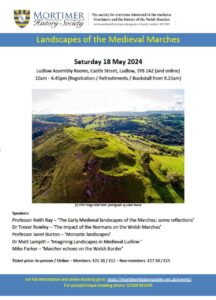[This post summarises a number of articles published in the media including CNN, The Independent, Shropshire Star, ITV and BBC. The original source was published in Nature, 20 September 2023. Images have been taken from those sources.]
 In a ground breaking discovery, archaeologists have unearthed an ancient wooden structure in Zambia, believed to be almost half a million years old. This find, located in the banks of the Kalambo river, has significantly altered the prevailing understanding of early human life.
In a ground breaking discovery, archaeologists have unearthed an ancient wooden structure in Zambia, believed to be almost half a million years old. This find, located in the banks of the Kalambo river, has significantly altered the prevailing understanding of early human life.
The research, published in the journal Nature, reveals that the wooden logs were likely used to construct what might have been shelters. This challenges the previously held belief that ancient humans led primarily nomadic lives. Instead, the evidence suggests that these early humans were capable of creating large, innovative structures using wood.
 Prof. Larry Barham expressed his astonishment at the discovery. He emphasized the significance of the find, noting that it demonstrates the intelligence, imagination, and skills of our early ancestors.
Prof. Larry Barham expressed his astonishment at the discovery. He emphasized the significance of the find, noting that it demonstrates the intelligence, imagination, and skills of our early ancestors.
Among the artifacts discovered were ancient wooden tools, including digging sticks. However, the most intriguing find was two pieces of wood positioned at right angles, with notches cut into them. These notches, believed to have been made using stone tools, allowed the logs to fit together, forming structural objects.
The age of the logs was determined to be approximately 476,000 years old, using luminescence dating. Some related wooden finds were dated just over 300,000 years old. Alternative analysis of the data gives older dates.
The discovery has also shed light on the ancient human use of wood. Prior to this, the primary evidence of wood usage was limited to making fire and crafting basic tools. The oldest known wooden artifact was a 400,000-year-old spear discovered in 1911.
The location of the find, near the Kalambo Falls on the Zambia-Tanzania border, provided the perfect conditions for wood preservation. The wood remained waterlogged, essentially pickling it for millennia.
The size of the logs suggests that the structure was substantial. While it’s unlikely to have been a permanent dwelling, it might have been part of a platform for a shelter or a structure for fishing. The exact species of ancient human or hominid responsible for this construction remains uncertain, as no bones have been found at the site. The timber predates the earliest known Homo sapien fossils, which are about 315,000 years old.
 The wooden artifacts, currently in the UK for analysis and preservation, will soon return to Zambia for display. The discovery is expected to provide valuable insights into the woodworking tradition in Zambia and the potential to deepen our understanding of ancient woodworking techniques.
The wooden artifacts, currently in the UK for analysis and preservation, will soon return to Zambia for display. The discovery is expected to provide valuable insights into the woodworking tradition in Zambia and the potential to deepen our understanding of ancient woodworking techniques.
This research is part of the Deep Roots of Humanity project, led by Prof. Barham from the University of Liverpool, which aims to explore the development of human technology during the Stone Age. The project is a collaborative effort involving teams from Zambia’s National Heritage Conservation Commission, Livingstone Museum, Moto Moto Museum, the National Museum in Lusaka and others. The dating was done at Aberystwyth University.
 The discovery has profound implications for our understanding of early human technology and cognitive abilities. The structure, made of worked timber, is believed to be the earliest evidence of humans crafting logs to fit together. This challenges the notion that Stone Age humans were purely nomadic.
The discovery has profound implications for our understanding of early human technology and cognitive abilities. The structure, made of worked timber, is believed to be the earliest evidence of humans crafting logs to fit together. This challenges the notion that Stone Age humans were purely nomadic.
Prof. Larry Barham emphasized the significance of the find, stating that it has reshaped his perception of early ancestors. He highlighted their ability to transform their surroundings, making life more convenient.
The site at Kalambo Falls had been previously excavated in the 1960s, where similar pieces of wood were found. However, the true significance of the site remained unclear until the recent discovery and subsequent dating methods. The availability of forest resources and a permanent elevated water table created a habitat conducive to sustained occupation. Life in a periodically wet floodplain would be enhanced by constructing a raised platform, walkway or foundation for dwellings.
In conclusion, the discovery of this ancient wooden structure in Zambia has provided invaluable insights into the capabilities and lifestyles of early humans. The find challenges previous beliefs about Stone Age humans and underscores the importance of wood in the human evolutionary story.









